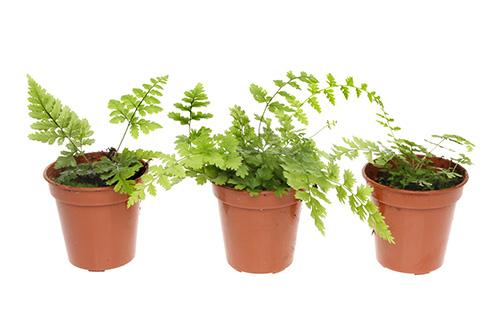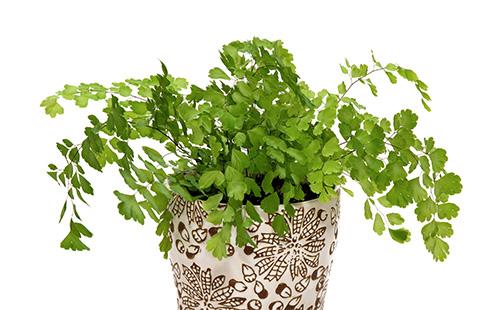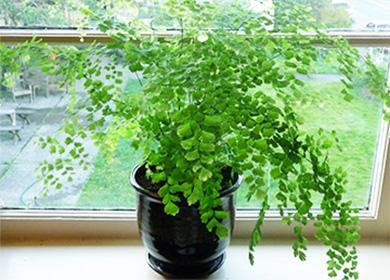The content of the article
Adiantum is an indoor perennial fern. A characteristic feature is the ability to repel water from the surface of leaves. Translated from Greek, the name of the plant means "non-wettable." Surprisingly, all the droplets that fall on the greens simply flow down, leaving not even a wet trace. Outwardly, it seems fragile and moody, but do not be afraid to start it at home.
The healing properties of the plant
Adiantum is not only beautiful, but also a medicinal plant, so you can safely plant it in beautiful pots and give it to friends. Adiantum leaves contain many useful substances. For example, lipids, essential oils, flavonoids can be found in their composition. Venereal hair leaves are the main or additional ingredient in infusions, syrups and powders. These drugs are successfully used by residents of Western Europe.
Syrups with adiantum leaves along with infusions are used during an illness to lower body temperature, and also as a coughing agent. Water extracts of adiantum leaves have antibacterial properties. Preparations based on adiantum are used in the treatment of diseases of internal organs, for example, the liver and bladder.
Juice from the leaves of venereal hair is used as a detox after being bitten by rabies. Also successfully used in the treatment of ulcers of malignant origin. Alcohol infusion of the adiantum will help with psoriasis. Well, the cosmetic effect is getting rid of dandruff by rinsing the head with a decoction of adiantum leaves.
Basic rules for caring for an adiantum
In the natural environment, this species of fern grows in a temperate tropical and subtropical climate, for example, in Europe, South Africa, the Mediterranean, Asia, and the Caucasus. Favorite places are near waterfalls, along streams and rivers. In total, in nature there are more than 200 species of adiantum. But it’s veneren hair that is the most popular and sought-after type by flower growers.
Those who want to admire this fern at home should know the basic rules on how to care for the adiantum.
- Shine. Adiantum absolutely does not like the sun, therefore, direct sunlight should be completely excluded from it.
- Temperature. Comfortable temperature for adiantum content is 15-22 ° C. Subject to temperature conditions, you can take the plant outside, but remember that it does not tolerate the smell of cigarette smoke and dust.
- A place. It is not necessary to put a pot with a bush on the windowsill, it will feel quite normal inside the room. But if you still put it on the window, then choose the north or east (with additional shading in the morning) side. If there is too much light, then soon the leaves will fade, turn yellow and fall off.
- Spraying. Adiantum loves moisture and coolness, so frequent spraying is suitable for him, but only if it is stuffy in the room.If the temperature is already comfortable, then spraying is optional - they may cause mold in the pot.
- Humidity. Watch the level of soil moisture - the earth should not dry out, but it does not need to be wet either. The drying up of an earthen coma is also detrimental to the plant - so the plant will begin to turn yellow and will have to completely cut the leaves. Particularly carefully you need to monitor the humidity on hot days. If in the cold season the air temperature in the room is low, then you can limit yourself to watering once a week.
- Fertilizers They need fern bush during the period of active growth, that is, in the summer. To maintain the richness of greens and strengthen the plant. Preference should be given to liquid top dressing, preferably organic.
Transfer
It is better not to leave plants in pots from the store. Usually the quality of the soil there is poor. Therefore, it is worth knowing how to care for the adiantum after the purchase. At first, the plant will acclimatize, get used to new conditions for it. It is likely that the plant will begin to turn yellow, in this case, you need to prune the damaged vayi and allow new ones to grow. The main thing is, do not rush to change his place or rush to fertilize: the plant has stress and this is quite normal. Follow all the rules of care and observe his well-being.
It would be nice to ask when buying about the suitability of the soil and how soon the bush needs to be replanted. From the answer it will become clear whether it is worth rushing with a transplant. Usually, the adiantum is transplanted in the spring as needed, this is every two years during the plant's youth, then - as it grows, that is, when it becomes crowded in the same pot. There are three tips on how to transplant the adiantum into another pot.
- Pot. An adiantum usually requires a wide pot, but not necessarily a tall one. That is, it can be a low wide bowl. Inexperienced flower growers believe that the larger the pot, the better, but this is a fallacy. Adiantum also feels well in cramped conditions, so there is no need to rush to a transplant.
- The soil. Adiantum loves loose, breathable soil. Ideal for him is a combination of leaf, turf, peat mix and sand. The addition of charcoal, bark and dolomite flour is allowed. Do not forget about the drainage layer, because stagnation of water is detrimental to the health of the fern.
- The condition of the roots. Carefully inspect the roots, all rotten should be removed, while not disturbing healthy roots in vain. The root neck does not need to be deeply buried. Be sure to remove all old, damaged, diseased and yellow leaves.
Care for the adiantum (venereal hair) in the pot after transplantation is the same as before. But in the first three to five days it is recommended to spray and water the plant, observing the rules of watering.

Breeding
There are two known methods of propagation of the adiantum: spores and division of the bush. Each of them is convenient and uncomfortable in its own way.
- By dividing the bush. Reproduction in this way is produced in the spring during transplantation. You need to carefully examine and study the growth points. If the growth point is one or more, but insignificant, then it is better to abandon the division. A successful outcome is possible only with a few significant points of growth, otherwise the plant is in danger of death. With a successful transplant, it is worth continuing normal care and watching. Please note that there will be no rapid growth. At first, the adiantum, most likely, will not grow at all, and then it will begin to grow slowly.
- Disputes. When choosing the second method, it is worth knowing a few nuances of how to propagate the adiantum with spores.In spring, you need to cut the sheet and remove spores from its lower side. Place spores on paper and dry a little. Then you need a box with peat, where the spores are applied in a uniform layer. “Seeds” need to create a greenhouse effect, that is, cover the box with glass or film, put in the shade and monitor the humidity. Open your greenhouse for a short time daily to let the ground breathe. But prevent drafts. Now be patient, because the shoots will have to wait a lot - a maximum of five weeks, the spores will germinate. As soon as you see small shoots, remove the glass (or film) and place the box in a bright place (but not in the sun!). After about two weeks, you can thin out the shoots and leave only the strongest plants. Once they are large enough and gain strength, they can be transplanted into permanent pots. Reviews about this transplant option are usually only positive.
Growing difficulties
Of course, there are pitfalls in growing adiantum, but they are not so significant as to abandon it. Improper care may cause such problems.
- Lethargy and yellowing of leaves. Most often this happens due to improper watering. It is necessary to water the adiantum correctly in order to avoid this trouble, by immersing the pot in water. As soon as the surface of the ground shines, you need to remove the pot from the water and let the excess liquid drain. This method is convenient in the summer. But be sure to let the water drain, otherwise mold may appear.
- Burns of the leaves. Or their pallor in bright light.
- Twisting the leaves. It can be from finding a fern in a draft, as well as during hypothermia or overflow.
- Drying leaves.If at the adiantum (venereal hair) the leaves become stained at the base and crumble, the tips dry, then the reason is the overdried air in the room.

Diseases and Pests
It is believed that the smell of fern repels all pests, but, alas, this has not been the case for a long time. Especially now, when many insects are resistant even to chemicals.
Spider mite
In excessively dry air, a spider mite may attack the adiantum. How to recognize it: on the stem you can see the cobwebs, the leaves dry, wither and fall off.
To get rid of the pest, you need to carefully remove the cobwebs and bathe the plant under a warm shower.
Fern shield
One of the most dangerous pests for the adiantum is the fern shield. It is necessary to fight it as soon as it appears on the plant. Initially, the scale shield is localized only on the lower part of the wai, then it gains strength and spreads throughout the entire bush. Pest must be eliminated by “Aktellik” or “Karbofos”, diluted in the ratio of 15-20 drops per liter of water. Sooty fungus forms on the secretions of the scabbard (and aphids, too), so it is important to notice the problem in time and eliminate it.
Aphid
If the leaves of the fern curl, turn yellow and fall, then most likely he was the victim of an attack of fern aphids. The location of its location is usually the lower side of the leaves. You need to fight with the means from the store, designed to eliminate these pests. If you find uninvited settlers on your plant, treat the bush with soap or Pyrethrum solution. In case of severe infection, use the same means as with the shield. After treatment, you can bathe the venus of hair in the shower.
Mealybug
Mealybug is another pest that, although rare, still appears on the adiantum. Not the worst enemy of the plant, but if you do not recognize the infection in time, you can lose your green pet. Regularly inspect the plant, if you notice a worm, then take a swab, soak in alcohol and gently wipe the location of the pests. If you looked and the infection is already strong, then the emulsion of “Karbofos” will help to save the bush.
Growing an adiantum at home is not a hassle. If you follow the simple rules of caring for a fern, it will delight the hosts with its greenery for a long time.
Reviews: “Looking at him is a pleasure”
I've been growing for many years and have never had a problem with it. Although I periodically “dry” it - I do not have time to water it on time. In this case, I cut off all the dried branches with scissors and start to water normally - after 1.5-2 weeks I have the plant in its original form.
❊ Natalia ❊, https://www.babyblog.ru/community/post/flowers/1717105
As in a flower shop on the shelf "Sale" noticed a small, completely withered, but so tender and weak Adiantum. It was a pity to leave him in this, for him not a favorite place, carried away with him.
At home, of course, she freed him from the wretched pot and transplanted him into her home. And literally a few days later new sprouts appeared, and two weeks later it was already a beautiful green bush. Looking at him is a pleasure.Scorpio, http://otzovik.com/review_2492360.html
Venus of hair, and if translated from Latin, the female fern, like all women, is unpredictable. In particular, I mean taking care of this plant. I did not have the most capricious friend in the pot. But I do not want to leave. Because when the venus of hair, or adiantum, after the next whim, quickly restores its magnificent cap, then, except for tender feelings, it causes nothing more. This plant needs moderate heat and humidity. Direct sunlight damages its leaves, but it is not worth planting it in the dark, since it is likely to get faded elongated strings instead of fluffy branches. Venus of hair belongs to ferns, therefore it is advisable to offer ordinary moss as a neighbor in the flowerpot, which will protect the soil from drying out and create an unusual green composition. Pouring water is also not worth it, they can rot the roots. I am sure that this plant will bring a fresh touch to your interior.
helen ch, http://otzovik.com/review_1729269.html

